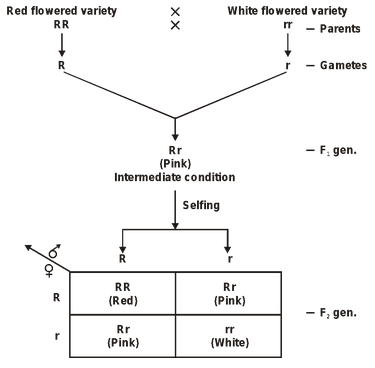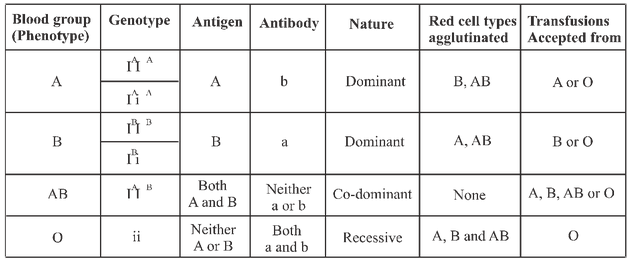
Gene Interactions (Post Mendelian Genetics)
Genetic Basis Of Inheritance of Class 12
Gene Interactions (Post Mendelian Genetics)
Phenotypic expression of a gene may be altered by the influence of other genes. The modification of the normal phenotype of certain genes by other genes is known as gene interaction.
The gene interaction is of 2 types :
- Intragenic Interactions : These interactions occur between the two alleles of same gene to produce a phenotype different from the normal dominant – recessive phenotype. The common intragenic interactions are incomplete dominance, codominance, multiple alleles.
- Intergenic Interactions : These interactions occur between the alleles of different genes present on the same or different chromosomes to alter the normal phenotype. The familiar intergenic interactions include complementary genes, supplementary genes, polygenes, epistasis, pleiotropy, lethal genes.
- Incomplete Dominance (1:2:1) : Sometimes two genes of allelomorphic pair do not show dominant–recessive relationship, but when present simultaneously (or come together), they show intermediate condition, which is called as incomplete dominance. It is due to the fact that the dominant character or gene is not in a position to completely suppress the recessive one. With the result, the heterozygote has a different phenotype (as well as different genotype) from homozygous for either allele.
First case of Incomplete dominance was reported in Mirabilis jalapa (4 o’clock plant) by Karl Correns (1903).
Incomplete dominance is found in both plants and animals. Good examples are seen in Mirabilis jalapa, the four–o’clock plant, Antirrhinum majus, the snapdragon and Andalusian fowl.
Example : 1.
In Mirabilis jalapa (4 o’clock plant, vern Gulbansi) and Antirrhinum majus (Snapdragon or Dog flower) there are two types of flower colour in pure state, red and white.
A cross between a plant pure for red flowers and a plant pure for white flowers yield hybrid plants with pink flowers in F1 generation. Neither red nor white is completely dominant, so that both colours appear in the hybrids as a blend which is pink. This is obviously a contradiction of Mendel’s assumption that no blending of characters takes place. When two of the hybrid plants with pink flowers are crossed, the F2 generation includes plants with red, pink and white flowers in the usual Mendelian ratio of 1 : 2 : 1

Fig: Incomplete dominance
This cross shows :
Incomplete dominance. The genes for red and white colour do not actually mix in the F1 pink hybrids as both the pure characters (red and white) reappear in the F2 plants. There is no specific gene for pink flowers.Quantitative effect of genes. The homozygous plants rr are unable to produce the flower pigment. The heterozygous plants Rr can produce only half the amount of flower pigment that is produced by the homozygous plant RR. In the F2 generation of the above cross ; The genotypic ratio is the same as Mendelian ratio, being 1 : 2 : 1 (1 RR : 2 Rr : 1 rr).
Example : 2.
MN blood type and ABO blood groups of human beings are controlled by a pair of co-dominant genes. Allele LM for M-type blood is co-dominant with its allele LN for N-type blood. The heterozygote (LM LN) expresses the characteristics of both M and N antigens (MN- type blood), that is LM LN heterozygotes possess red blood cells that carry both M and N antigens on their surfaces. A mating between a homozygous. M-type person (LM LM) and a homozygous N-type (LN LN) would result in all heterozygous offspring. Mating between heterozygotes (LM LN × LM LN) would result in a ratio of 1 M-type (LM LM) : 2MN-type (LM LN) : 1 N-type (LN LN).
Example : 3.
The sickle-cell haemoglobin Hbs and normal haemoglobin HbA are codominant in the persons that are carriers of sickle-cell trait.
ULTIPLE ALLELES
More than two allelic forms of certain genes are called multiple alleles. They occur on the same gene locus, distributed in different organisms in the gene pool with an organism carrying only two alleles and a gamete only one allele. The mode of inheritance in such cases was called multiple allelism.
There is a wild type dominant allele designated with a superscript of (+) or capital letter. The completely recessive allele is without any superscript. Other alleles are mutants of either of the two. They show amongst them dominant-recessive, co-dominance and incomplete dominance. Multiple alleles probably exist for most, if not all, genes.
A well known example is the ABO blood groups in humans.The four human blood groups A, B, AB and 0 are the four phenotypes for this trait. The letters A and B refer to the two types of glycoproteins (antigens) coating the red cells of persons with either type A or type B blood, respectively. Type AB blood cells contain both the glycoproteins while type 0 blood contains neither. Three different alleles IA IB and i of a gene determine the phenotypes of four blood groups. Allele IA determines the formation of antigen A and allele IΒ the formation of antigen B. Any person carries only two of these alleles, one from each parent. However, with three alleles, it is possible to obtain six genotype combinations as follows:

Fig: Blood group combination
Both IA and IB are dominant over i, but not over each other. IA and IB show co-dominance between them producing AB blood group. Blood group 0 is produced when two recessive alleles are present. The ABO blood group is, therefore, an example of both multiple allelism and co-dominance.







